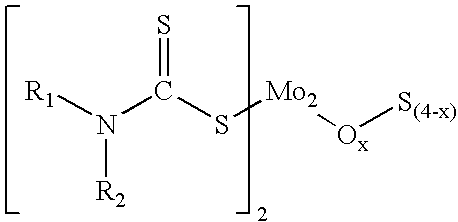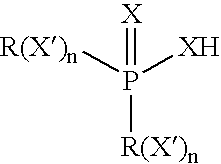Organo-imido molybdenum complexes as friction modifier additives for lubricant compositions
a molybdenum complex and additive technology, applied in the field of lubricating oil additives and lubricant compositions, can solve the problems of limiting the service life of catalytic converters, dikyldithiophosphates giving rise to ash, etc., and achieve the effect of reducing the coefficient of friction of lubricants
- Summary
- Abstract
- Description
- Claims
- Application Information
AI Technical Summary
Benefits of technology
Problems solved by technology
Method used
Image
Examples
example 1
Bis-tert-butylimidomolybdenum(VI) dichloride, DME adduct
[0092]All operations with molybdenum derivatives were carried out in an atmosphere of dry argon. Anhydrous Na2MoO4 (30.9 g, 0.15 mol), absolutized DME (0.5 L), triethylanine (84 mL, 0.6 mol), trimethylsilylchloride (152 mL, 1.2 mol), and tert-butylamine (31.3 mL, 0.3 mol) were mixed in a 1 L flask, and refluxed for 12 hours. The Na2MoO4 was completely dissolved. The reaction mixture was filtered and the solid (Et3HN+Cl−) was washed twice with DME and once with hot heptane. The solvents were removed in vacuo from the combined liquid phases, and the greenish solid mass obtained was vigorously shaken with cold hexane. The hexane was filtered off to yield 42.5 g (70%) of yellow crystals.
example 2
Bis-tert-octylimidomolybdenum(VI) dichloride, DME adduct
[0093]All operations with molybdenum derivatives were carried out in an atmosphere of dry argon. MoO2Cl2·DME (18 g, 0.0625 mol), tert-octylamine (20.1 mL, 0.125 mol), triethylamine (35 mL, 0.25 mol), trimethylsilylchloride (31.6 mL, 0.25 mol), and DME (200 mL) were mixed together and refluxed for 5 hours. After cooling the solution to room temperature, the precipitate was filtered off, the solution was evaporated under diminished pressure to ¼ of its initial volume, and the filtration was repeated. Then, the remaining solvents were removed in vacuo, providing a red oily product, which was recrystallized twice from pentane at −110° C. A red crystalline solid was obtained. The yield was 23 g (72%).
example 3
Bis-(tert-butylimido)-bis-(diisooctyldithiocarbamato)molybdenum (VI)
C42H86MoN4S4
[0094]All operations with molybdenum derivatives were carried out in an atmosphere of dry argon. To a solution of bis-(iso-octyl)amine (10.6 mL, 0.0351 mol) in diethyl ether (200 mL) at 0° C., a 1.48 M solution of butyllithium in hexane (24 mL, 0.0351 mol) was carefully added with stirring. After stirring the mixture for 10 minutes, CS2 (2.1 mL, 0.0351 mol) was carefully added, and the temperature allowed to rise to 20° C. Then, a solution of 7 g of Example 1 Product (0.0175 mol) in 50 mL DME was added, and after stirring for two hours, the solvents were evaporated under reduced pressure to a volume of 50 mL, One hundred mL of n-hexane was added, and the solution was filtered. The filtrate was evaporated in vacuo, and 15.5 g of a dark-red oil was obtained.
PUM
 Login to View More
Login to View More Abstract
Description
Claims
Application Information
 Login to View More
Login to View More - R&D
- Intellectual Property
- Life Sciences
- Materials
- Tech Scout
- Unparalleled Data Quality
- Higher Quality Content
- 60% Fewer Hallucinations
Browse by: Latest US Patents, China's latest patents, Technical Efficacy Thesaurus, Application Domain, Technology Topic, Popular Technical Reports.
© 2025 PatSnap. All rights reserved.Legal|Privacy policy|Modern Slavery Act Transparency Statement|Sitemap|About US| Contact US: help@patsnap.com



